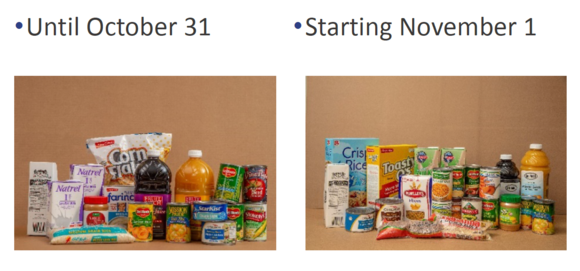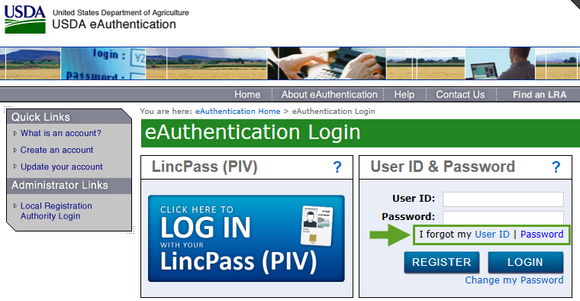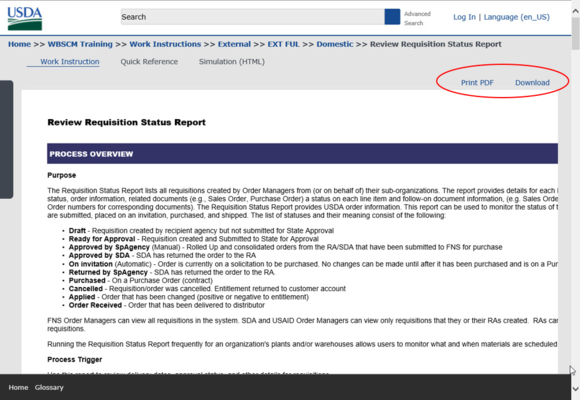USDA Foods Trade Mitigation Food Purchase Update
USDA has begun making purchases under the Trade Mitigation Food Purchase and Distribution Program to support American agricultural industries impacted by recent tariffs. USDA has completed the purchases for Phase 1 (December 2018 through March 2019 deliveries) and Phase 2 (April 2019 through June 2019 deliveries). To date, over $500 million has been purchased from the product categories shown below. These purchases will support Food Banks and other emergency feeding organizations that receive food through The Emergency Food Assistance Program (TEFAP). In future purchases, some trade mitigation products will also be made available to programs receiving USDA Foods through the National School Lunch Program (NSLP), Child and Adult Care Food Program (CACFP), Commodity Supplemental Food Program (CSFP), and Food Distribution Program on Indian Reservations (FDPIR).
In Case You Missed It: CSFP Food Package Enhancements Coming Soon!
This photo shows what a sample CSFP food package could look like when the changes go into effect in November 2019.
On February 22, the USDA Food and Nutrition Service (FNS) announced upcoming changes to CSFP that will increase variety and flexibility within each food package category. The changes will be effective on November 1, 2019, and will include the following:
- Double the amount of vegetables
- More plant-based proteins including canned beans and lentils
- Pack sizes that are more appropriate for small households and allow participants to receive a greater variety
 FNS developed a CSFP Food Package Toolkit with information and resources to help you prepare for the upcoming changes. Here are the latest resources to help you transition to the new CSFP Food Package:
Additional resources will be developed in the coming months and posted to the CSFP Food Package Toolkit. Subscribe to the Special Edition CSFP e-letter to receive the latest news, resources, and training opportunities each month.
CSFP Webinars

We just started our CSFP Food Package webinar series to help you transition to the enhanced CSFP Food Package. Recordings are now available for the first two webinars:
Title: CSFP Food Package: What You Need to Know! (2/28/2019) – Listen to the recording now!
Description: The USDA Food and Nutrition Service is making significant revisions to the CSFP food package in response to feedback from the CSFP community! This is the first of a series of webinars that will help CSFP states and local agencies prepare to implement the food package changes. Join this webinar to hear what will be changing in the food package and have an opportunity to ask questions.
Title: CSFP Food Package: Ordering Guidance for Direct Shipments (3/7/2019) – Listen to the recording now!
Description: Join us for more information on CSFP Food Package Changes and how to adjust direct shipment ordering to prepare for implementation starting this November. We will review products that will be phased out, new material codes (pack sizes) that will be added to the catalog as well as anticipated new product offerings. We will discuss catalog availability and ordering deadlines and how to anticipate direct ship needs for the new guide rate. This webinar is for states that receive direct shipments.
We have more CSFP Food Package webinars scheduled in the coming months!
Are you interested in attending a live CSFP Food Package webinar? Subscribe to receive all CSFP webinar announcements!
|
USDA Foods Beef Stew Gets a Makeover

It may look like the same package, but it is no longer the same product! Based on feedback from our program participants, USDA has been working to revise the requirements for the beef stew available in TEFAP, CSFP, and FDPIR. The changes ensure more consistency between vendors and improve the quality and visual appeal of the product. Changes include adding a minimum requirement the for amount of vegetables and their size, in addition to changing the type of meat to a whole muscle cut to ensure a chunkier formulation. We are also working with vendors to ensure that all labels will be colorful and include a photo of the product. Be on the lookout for this new formulation in your program soon!
|
FY2019 Funding Update
On February 15, 2019, President Trump signed the Consolidated Appropriations Act, 2019 (P.L. 116-6, the Appropriations Act), which provides full Fiscal Year (FY) 2019 funding for TEFAP, CSFP, and FDPIR. TEFAP will receive $109.63 million in administrative funding and $306.083 million in food funding. CSFP was funded at $222.891 million which supports existing caseload levels as well as the addition of new state agencies with approved state plans – Alabama, the Spirit Lake Sioux Tribe in North Dakota, and the Shingle Springs Band of Miwok Indians in California. FDPIR will receive a total of $153 million in addition to $998,000 for Food Distribution Program Nutrition Education (FDPNE) grants. FDPIR FY19 funding will also remain available for two fiscal years through September 30, 2020.
FNS Releases 2019 CSFP Final Caseload
The Consolidated Appropriations Act, 2019 (P.L. 116-6, the Appropriations Act) provided $222.891 million for CSFP for FY 2019. Based on this full-year funding level and available resources, FNS issued 2019 CSFP final caseload assignments, or the number of people each state or Indian Tribal Organization (ITO) is authorized to serve. These 2019 final caseload assignments are effective March 1, 2019 and they maintain the 2018 national caseload level of 728,552 for currently participating CSFP states and ITOs, and include 7,558 slots for a new state, Alabama, and two new ITOs, the Spirit Lake Sioux Tribe in North Dakota and the Shingle Springs Band of Miwok Indians in California. FNS assigns caseload in accordance with program regulations at 7 CFR 247.21 and annual appropriations legislation. CSFP is now administered in all 50 states, the District of Columbia, Puerto Rico, and five ITOs.
The 2018 Farm Bill Makes Changes to CSFP Certification Periods
On March 8, the FNS Supplemental Nutrition and Safety Programs, Food Distribution Division released a memorandum which implements the provisions of the Agriculture Improvement Act of 2018 (Farm Bill) (P.L. 115-334). Section 4102 of the Farm Bill changes CSFP certification requirements outlined in 7 C.F.R. 247.16, effective immediately. As a result, states and ITOs are required to establish new certification periods of between one and three years for program participants. States and ITOs are also permitted to continue to provide temporary monthly certifications to eligible CSFP applicants to fill any caseload slots resulting from nonparticipation by certified participants.
FNS will be updating program regulations at 7 C.F.R. 247 to implement the Farm Bill’s CSFP provisions. In the meantime, the above referenced memorandum, “CSFP – Implementation of the Agriculture Improvement Act of 2018,” serves as interim guidance for CSFP state agencies and ITOs and is effective immediately. CSFP state agencies and ITOs with questions regarding implementation should review the memorandum or contact their FNS Regional Offices.
The 2018 Farm Bill requires CSFP States and ITOs to establish new certification periods for program participants.
2019 National Anti-Hunger Policy Conference
USDA staff presented a session at the 2019 National Anti-Hunger Policy Conference in Washington, D.C. During this session, staff facilitated round table discussions about four different topics: policy updates, state best practices for TEFAP, food operations, and the changes to the CSFP food packages. The table discussions were dynamic and provided an opportunity for staff to hear questions and have dialogue directly with program operators. We thank everyone for their participation in this session! For those of you who were unable to attend, we want to remind you that if you have questions or feedback about any of our USDA Foods programs, you can always contact us directly at USDAFoods@fns.usda.gov.
WBSCM News & Updates
WBSCM Login Help
During the registration process, Web Based Supply Chain Management (WBSCM) users create login credentials in a separate system called eAuthentication. To recover forgotten information, tools are available from the login screen via the I forgot my User ID | Password links, as shown below.
 To recover forgotten User ID(s), click on User ID. After entering your information, you will receive a list of any User ID(s) linked to this email.
To reset a forgotten Password, click on Password. You will be prompted to enter your User ID and answer the security questions you established during set up. After confirming your identity, you will be prompted to enter a new password. This action will also unlock your account if you had entered the wrong password too many times. Note: The Change my Password link can be used to update your account only if you know your current password.
If you have forgotten both your password and your security question responses:
-
Users with a LincPass (USDA-issued ID) should contact the eAuthentication Service Desk for assistance at 1-800-457-3642, option 1.
-
Users without a LincPass will need to reestablish access to WBSCM with a new login ID. Contact the user administrator for your organization for assistance.
WBSCM Help Resources
The (WBSCM) system is under continuous improvement through monthly development activities. The latest release includes these improved training materials:
- Create Multi-Food Order (SDA)
- Create Multi-Food Order (RA)
- Create Domestic Requisition (SDA)
- Create Domestic Requisition (RA)
- Modify Domestic Requisition
When logged in, users can access training materials through on-screen help, by browsing the full library, or by performing a keyword search. A short tutorial on the announcement banner at Help -> Welcome, provides an overview of WBSCM navigation and accessing help features.
 To browse training materials, navigate to Help -> Training -> and drill down through the categories, user groups, and functional areas or topics. Most documents will display in a separate browser window or tab, with options to download as PDF or other format(s), as shown below.
 Available resource types include:
-
Work Instruction – step-by-step instructions for common transactions, with optional screenshots and detailed field descriptions
-
Job Aid – general guidance and quick reference tools for working in WBSCM
-
Simulation – an audiovisual walk-through of a transaction, with option for interaction or view-only playback
-
Course Material – self-paced learning for a particular functional area and user group.
-
Release Notes – summary of all changes introduced to WBSCM each month, including the impacted user groups and links to related training materials
Additional resources are available from the FNS webpage for WBSCM, including system and browser requirements, an FAQ, and examples and templates for uploading or downloading data from WBSCM.
For additional assistance, contact the WBSCM Service Desk or call (877) 927-2648.
USDA staff will be participating in these upcoming meetings in 2019. We look forward to meeting you and hope to see you there!
May 5-8: American Commodity Distribution Association (ACDA) Annual National Conference in Niagara Falls, New York.
June 9-12: National Commodity Supplemental Food Program Association (NCSFPA) Annual Conference in Alexandria, Virginia.
|